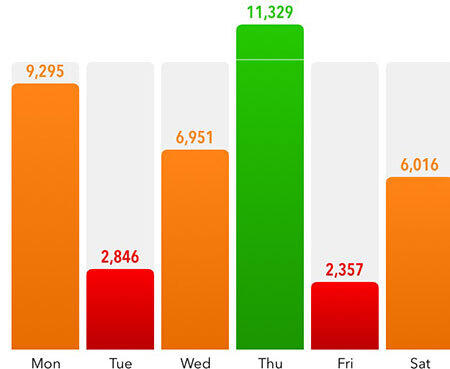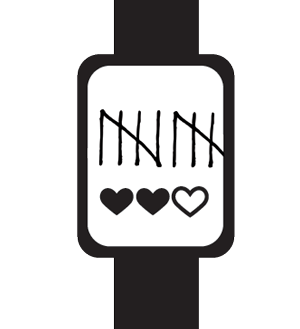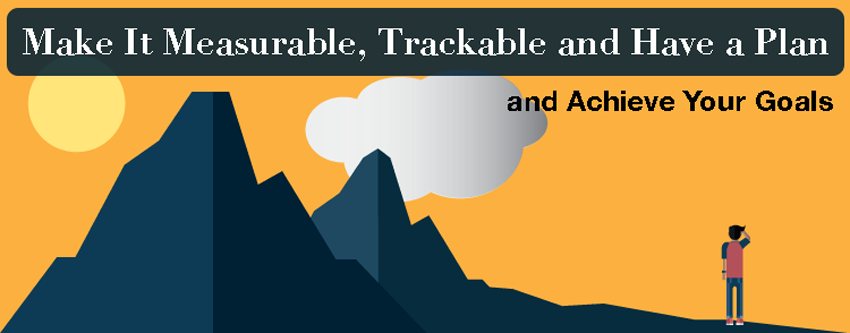Rarely do we fail at our goals because they are simply too hard or we are too busy. We in general fail at a goal because we didn’t make it a habit.
The simple answer to why some people succeed at so many things and others don’t is that successful people create feedback-driven processes and habits. They set an objective that is reasonable and has measurements to know if you are getting there. They come up with a way to track and see progress as you work on that goal or projects. And they follow and modify a expert plan to get there.
To increase your chances of achieving your goals, the formula is simple: you need to set a goal you can measure, a goal you can track, and a goal you can build a plan around.
Step 1: Make It Measurable

With goals we often talk about creating “S.M.A.R.T.” goals, which means goals that are Specific, Measurable, Achievable, Realistic and Time-based.
Your goal should be clear and specific and avoid vague hopes without anything you can realistically achieve within a certain amount of time. It’s recommended you give yourself a maximum of few months for your timeline and avoid intermediate goals that span more than a year. It’s better to have a smaller goal over a shorter time period, even if that bigger goal is on the radar for later.
For me, the most important aspect of goals is making them measurable. We often make the mistake of setting an ambiguous but nonspecific goal, like “lose a lot of weight” or “make more money,” but the research on goals shows that your success increases when you make them specific and have a way to measure your progress.
So, whether it’s health, creative or something else, you need to try and establish a measurement for its success and ideally some mid-term goals to get there. For example, if you want to write a novel, set a goal of writing 1000 words per day or if you want to run a marathon set a goal of running 40k per week.
It’s possible with each and every goal to make it measurable. Once you make it measurable, your chances of success go way up.
Step 2: Start Tracking It

As soon as you got a specific goal with a defined, measurable objective, you can start to think about implementing a plan and system to getting there. For whatever goal or objective you have, the first thing you should think about is how to track it.
We live in one of the greatest times for self-tracking. So, whether it’s tracking your food, your word count, your weight, your steps, or nearly anything else, there are tools out there to help record your daily progress. We haven’t quite made the data we track insight-driven, but progress is being made.
If you can track it, you should track it. If your goal is health- or fitness-related, I highly advise you to get an activity tracker or smart watch. These devices make it super simple to track how many steps you are getting and often times much, much more like your heart rate and even sleep. For more hardcore fitness pursuits like running a marathon, there are even dedicated sports trackers and running apps that help you get even more data about your improvements.
The key to tracking anything, but especially goals and habits, is to try and make it as passive and automatic as possible. So, your activity tracking should automatically record your daily steps and workouts. Similarly your writing tool should record your daily word count and your time tracker should measure how productive your time usage was.
Obviously some goals require manual logging, so in this case find a tool or habit tracker that works best for you. If you prefer email, use a tool that you can respond to via email like AskMeEvery or if you want it on mobile or a smart watch with notifications, find an app like Streaks or Productive that you can do your check-in’s there. If you are looking for a habit tracker with social gamification, checkout Habitica.
I encourage you to try a few options for tracking your goal. But once you find something that works good enough, use it. Avoid the dreaded “tool trier” syndrome where you continually try each and every application in a field in the hopes of finding the perfect one. There is no perfect one and your research is an excuse to avoid doing the work. Instead, once you find one that makes it easy to track, stick to it.
The key to successfully completing your goals is to track it continuously from beginning to end. This creates a history. You should be logging your progress daily or at least multiple times per week. Hopefully through regular tracking you both create a good habit and have data to give you feedback on your progress.
Step 3: Create and Modify Your On-Going Plan
Now that you have a measurable goal and a reliable way to track it, you can start to think about a plan. Like the obsession with finding the perfect tool or app for X, we often become obsessed with finding a perfect plan for achieving our goals. There is no perfect plan and instead you need to use and work on a plan that works for you.
Fortunately, to start out, there are dozens and dozens of articles and books on nearly any goal you might have. These plans can be a helpful starting place for building your own plan.
At the beginning start with a plan that makes sense to you and doesn’t require a ton of extra steps to getting started. It should be easy enough for you to understand and feel comfortable doing. Hard is okay but make sure it reasonable for your current level and situation. Then commit to following through with that plan for several weeks.
Some goals come with no plans, but that’s rarely the case today with so many experts sharing their advice, knowledge and research. In fact we might run into a situation of having too many plans to choose from.
It’s incredibly hard to achieve a goal without a plan since you will end up spending mental energy figuring it out rather than pursuing your dream. But don’t worry if your plan isn’t 100% perfect since no plan is.
If the plan feels like it is working and your tracking data is showing progress, then stick to it. If it’s failing completely, then throw it out for a new one. If the plan is only partially successful, then modify or revise it based on new studies and guidance so you can keep making progress.
The key thing is to have a plan, even if it is an on-going plan you modify and tweak. Your plan is part of an process taking you closer and closer to your goal. Ultimately use your tracking data and general feeling to decide what works best. Have a plan but don’t be afraid to adjust it.
Conclusion: Noticeable Feedback Towards Your Goal
We all fail at our goals from time to time. Every single successful person carries some baggage of a major setback or failure. The successful people find a way to rise from failure stronger. It’s part of the journey.
In my experience pursuing multiple dreams and goals, you can significantly increase your success by focusing on building habits and routines. Once a goal becomes a habit, you are bound to make continual progress.
The recipe is straight-forward: set a goal you can measure and you can track reliably, and then work on an active plan that can get you there..
You should be getting noticeable feedback in some way as your pursue your goal. That way you know that you are making progress. Positive and negative feedback are key aspects of getting closer to your objective. If you are not getting feedback or noticing changes, then there is a problem in your tracking, your plan or execution of that goal.
In the end, it’s you that will make the goal happen. Your plan is just your working notes and your tracking data is just your progress markers on your journey to get there.
Good luck on your goals and happy tracking!

